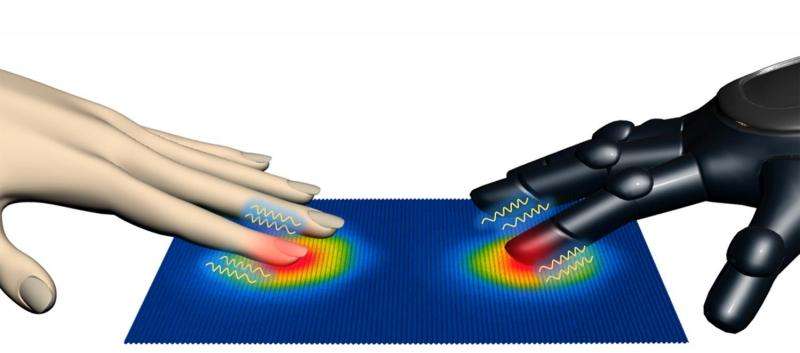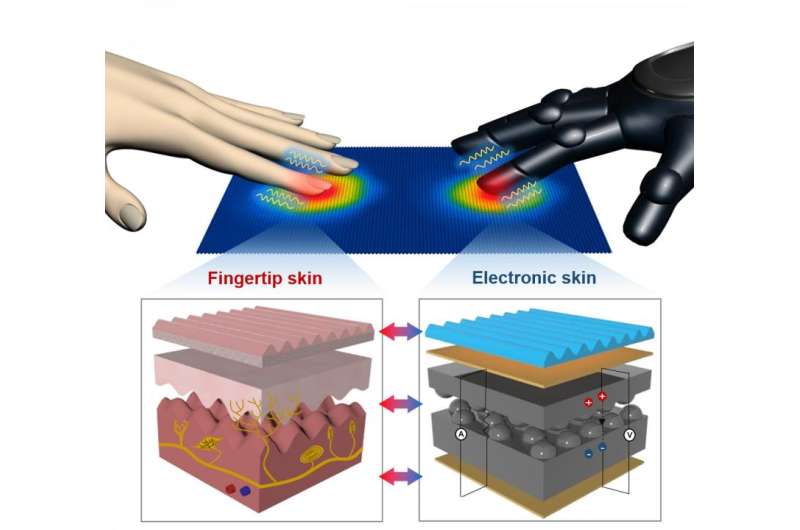November 2, 2015 report
New artificial skin can detect pressure and heat simultaneously

A team of researchers with Ulsan National Institute of Science and Technology and Dong-A University, both in South Korea, has developed an artificial skin that can detect both pressure and heat with a high degree of sensitivity, at the same time. In their paper published in the journal Science Advances, the team describes how they created the skin, what they found in testing it and the other types of things it can sense.
Many scientists around the world are working to develop artificial skin, both to benefit robots and human beings who have lost skin sensation or limbs. Such efforts have led to a wide variety of artificial skin types, but until now, none of them have been able to sense both pressure and heat to a high degree, at the same time.
The new artificial skin is a sandwich of materials; at the top there is a flexible surface meant to mimic the human fingerprint (it can sense texture), beneath that sit sensors sandwiched between graphene sheets. The sensors are domed shaped and compress to different degrees when the skin is exposed to different amount of pressure. The compression also causes a small electrical charge to move through the skin, as does heat or sound, which is also transmitted to sensors—the more pressure, heat or sound exerted, the more charge there is—using a computer to measure the charge allows for measuring the degree of sensation "felt." The ability to sense sound, the team notes, was a bit of a surprise—additional testing showed that the artificial skin was actually better at picking up sound than an iPhone microphone.

The artificial skin still has a long way to go before it could be used for practical purposes, the team acknowledges—they have yet to develop a means for communicating data from the skin to a robot or human being, for example, though that is one of the major areas of research that that group is focusing its attention on—they plan to develop a means for doing so that takes into account the special capabilities of the skin they developed, rather than simply hooking it to an already existing system or device.
More information: J. Park et al. Fingertip skin-inspired microstructured ferroelectric skins discriminate static/dynamic pressure and temperature stimuli, Science Advances (2015). DOI: 10.1126/sciadv.1500661
Abstract
In human fingertips, the fingerprint patterns and interlocked epidermal-dermal microridges play a critical role in amplifying and transferring tactile signals to various mechanoreceptors, enabling spatiotemporal perception of various static and dynamic tactile signals. Inspired by the structure and functions of the human fingertip, we fabricated fingerprint-like patterns and interlocked microstructures in ferroelectric films, which can enhance the piezoelectric, pyroelectric, and piezoresistive sensing of static and dynamic mechanothermal signals. Our flexible and microstructured ferroelectric skins can detect and discriminate between multiple spatiotemporal tactile stimuli including static and dynamic pressure, vibration, and temperature with high sensitivities. As proof-of-concept demonstration, the sensors have been used for the simultaneous monitoring of pulse pressure and temperature of artery vessels, precise detection of acoustic sounds, and discrimination of various surface textures. Our microstructured ferroelectric skins may find applications in robotic skins, wearable sensors, and medical diagnostic devices.
© 2015 Tech Xplore




















